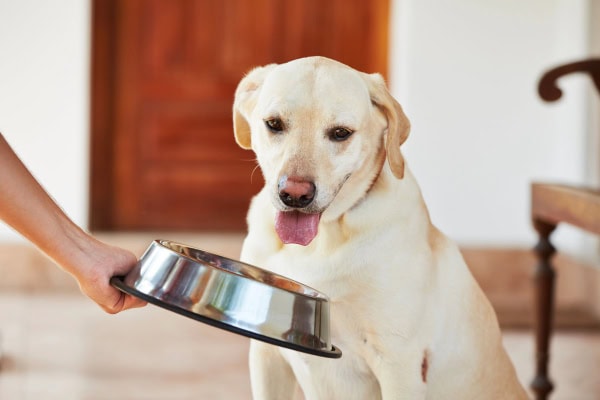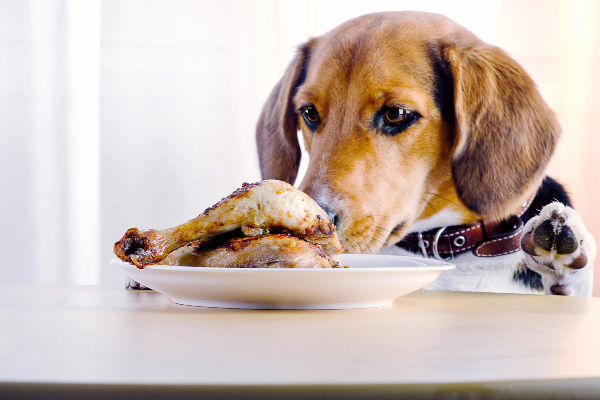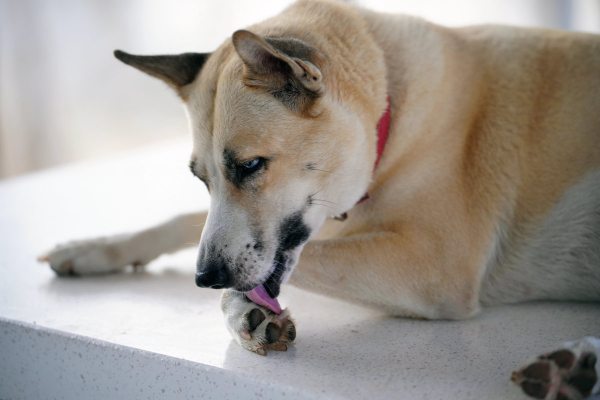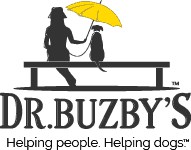A food allergy in dogs can cause severe itching, skin and ear infections, and sometime even GI upset. To help dog parents understand what caring for a dog with a food allergy entails, integrative veterinarian Dr. Julie Buzby lists the common food allergens, discusses the symptoms of a food allergy, and explains how to perform a food trial to diagnose and manage food allergies.

The prevalence of food allergies in humans has continued to rise in recent years. In fact, a 2024 study revealed that roughly 11% of the U.S. population over 18 years of age has at least one documented food allergy.
Dogs aren’t immune to food allergies, either. In fact, they are currently the third leading cause of allergies in dogs, behind flea allergy and environmental allergy. It is estimated that 1-2% of the general population of dogs, and 9-40% of the dogs who are brought to the vet for itching have a food allergy.
What is a food allergy in dogs?
A food allergy in dogs, also known as a cutaneous adverse food reaction (CAFR), is an abnormal immune response triggered by a specific food ingredient, which typically manifests as skin or GI signs.
Normally the dog’s immune system tolerates the ingredients in food. However, in a dog with a food allergy, the immune system mistakenly identifies a particular ingredient in the food as “foreign.” As a result, the dog’s immune system mounts an allergic reaction. And the dog starts showing clinical signs such as itching, GI upset, and skin and ear infections.
It’s worth noting that a food intolerance is not the same as a food allergy. Food intolerance (or food sensitivity) occurs in dogs who experience digestive difficulties due to some component of the diet. It usually results in vomiting, diarrhea, and excess gas. But the food does NOT trigger the immune system to mount an allergic response.
What are the most common food allergies in dogs?
More often than not, the ingredient the dog is allergic to is the protein or carbohydrate source. Based on a study of almost 300 dogs, the most common food allergens in dogs are:
- Animal proteins—beef (34% of dogs with food allergies), dairy products (17%), chicken (15%), pork (2%), fish (2%), lamb (5%), and eggs (4%)
- Grains—corn (4%), wheat (13%), rice (2%)
- Legumes—soybeans (6%)

There can also be some cross reactivity between ingredients. For example, a dog who is allergic to chicken may also be allergic to other types of poultry and to fish.
Which dogs are more prone to having a food allergy?
Any dog of any age can develop a food allergy. However, certain dog breeds, including Labrador Retrievers, West Highland White Terriers, and Cocker Spaniels, may be predisposed to them.
Additionally, approximately 22% of dogs will develop signs of a food allergy by the time they are six months old. However, symptoms also commonly start when the dog is an adult or senior.
What are the food allergy symptoms in dogs?
Interestingly, food allergy symptoms show up after a dog has consumed a food for a period of time—often years. This is because it takes time for the immune system to develop a sensitivity to the particular ingredient. Understandably, this can be confusing for dog parents. Many expect that food allergy symptoms would correlate with changing to a new food, but that usually isn’t the case.
Some of the most common signs of a food allergy in dogs include:
Intense itching
Dogs who have a food allergy are very itchy. They may lick and chew their paws and legs, rub their faces on the ground, scratch at their belly, armpits, or ears, or just generally seem itchy everywhere.
Chronic ear infections
Since ears are just an extension of the skin, dogs with allergies may start itching their ears or shaking their head due to an ear infection (otitis in dogs). You may also notice smelly debris in the ear and irritation of the ear canal.
Approximately half of the dogs with a food allergy will have ear infections. And for some dogs, chronic ear infections are the only sign of a food allergy.
Changes to the appearance of the skin
Dogs may develop red skin (erythema) from inflammation and the resulting licking and chewing. Because of chronic irritation over time, dogs with a food allergy that has been going on for awhile may also have darkened areas of the skin (hyperpigmentation) and thickening of the skin (lichenification).
Hair loss
You may notice your dog is losing hair, especially around the face, belly, armpits, groin, and legs.
Skin infections
When the skin gets traumatized by itching, yeast or bacteria can invade and set up an infection. This may look like little bumps or pimples, crusts, or circular areas of flaky skin in the case of a bacterial skin infection (pyoderma in dogs). Or the dog could develop red itchy feet due to a dog paw yeast infection. Sometimes a food allergy can also cause a rapidly-appearing moist and inflamed area of hair loss (dog hot spot).
Scooting the rear end on the ground
Anal gland issues in dogs (impaction, infection or rupture) or itchiness of the area around the anus in the absence of a problem with the anal glands may occur in dogs with food allergies. In both cases, you may notice the dog scooting or excessively licking the area under the tail.
Salivary staining
If your dog has white or lighter colored fur, you may notice rust-colored staining from saliva on the areas the dog licks frequently. Salivary staining tends to occur on the feet when the dog licks and chews on itchy dog paws. But it can also be on the legs or other locations that are easy to reach with the mouth.

GI signs
Approximately 6-44% of dogs with a food allergy will also show some vomiting, diarrhea, increased gassiness, abdominal pain, drooling, straining to pass stool, weight loss, or other symptoms related to the gastrointestinal tract.
Hives and facial swelling
While fairly rare, some dogs with a food allergy may show signs that are more in line with what we think of as an allergic reaction. They include hives (which can look like areas where the fur is standing up a bit more than usual) or facial swelling.
Sneezing and eye discharge
Occasionally, dogs with a food allergy will sneeze more often. Or they may develop red eyes with clear discharge due to conjunctivitis.
How do you test for food allergies in dogs?
Many of the signs of food allergies also occur in the other two common allergies in dogs— flea allergy dermatitis in dogs (an allergy to flea saliva) or seasonal allergies in dogs.
Plus, dogs may have more than one type of allergy. This can make reaching a diagnosis a bit challenging. The veterinarian will typically start by taking a history and performing a physical exam. Then he or she will discuss further diagnostics such as a food trial.
Gathering a history
Your veterinarian may ask you questions such as:
- Is your dog on a flea preventive? If so, which one and when was the last dose?—This information can help move flea allergy higher or lower on the differential list.
- When are your dog’s signs the worst?—Dogs with a food allergy typically have non-seasonal pruritis, meaning that their itching is the same year round. Flea allergy tends to be worse seasonally when fleas are more active. And environmental allergies may be worse seasonally if the culprit is a weed or pollen, or constant through the year if the dog is allergic to something indoors like dust mites.
- What food is your dog eating now? Which other diets has your dog been on in the past?—The vet needs to know what protein and carbohydrate sources your dog has already been exposed to when planning a food trial to diagnose food allergies (more on this soon).
- Have you tried anything at home to control your dog’s symptoms? If this happened in the past, what worked for your dog then?—This information helps with formulating a treatment plan.
- How itchy is your dog on a scale of 1 to 10, with 1 being barely itchy and 10 being almost constant itching?—Knowing where your dog’s itch score starts allows you and the vet to track his or her response to treatment.
Performing a physical exam
Next your vet will look your dog over from nose to tail. He or she will carefully check your dog for fleas. Plus the vet will note any areas where there are changes to the skin, hair loss, signs of infection, or other abnormalities.
Sometimes the pattern of distribution of the hair loss and skin inflammation can point to the cause. Dogs with food and environmental allergies are more likely to have symptoms involving the feet/legs, belly/armpits/groin, and face/ears. On the other hand, dogs with flea allergies may have itching and hair loss over the base of the tail and thighs. However, this isn’t always the case.
Using a food trial to test for food allergy in dogs
The gold standard protocol to diagnose food allergies is a food trial, also known as a diet elimination trial. This involves transitioning your dog to a special diet and feeding that exclusively for 8-12 weeks.
The vet will recommend one of three diet options for the food trial:
- Novel protein commercial diet—This is a prescription food that contains a protein source your dog has never ingested. Some examples include kangaroo, alligator, bison, or wild boar. Picking a good food for the diet trial involves knowing what your dog ate in the past since more and more regular dog foods now contain protein sources that used to be novel such as salmon, venison, or duck.
- Hydrolyzed protein diet/elemental diet—A hydrolyzed diet consists of smaller pieces of familiar proteins called peptides that are more easily digested and less likely to trigger an allergic response. An elemental diet takes it one step further by breaking the protein into amnio acids. Many veterinary dermatologist think hydrolyzed or elemental diets may be superior to novel protein diets because it can be nearly impossible to know every protein source your dog has eaten in the past to pick a novel protein. With a hydrolyzed diet, it doesn’t matter what you fed your dog before because you aren’t depending on the protein being novel.
- Homecooked diet—Some dog parents may chose to home cook a novel protein diet. However, it is important to consult with a veterinary nutritionist to ensure the recipe you are using adequately meets your dog’s nutritional needs.

Don’t use over-the-counter commercial diets for a food trial
Limited ingredient non-prescription foods are not an acceptable substitute for prescription diets during a diet elimination trial. Pet food facilities that produce most non-prescription pet foods use the same production lines to make a variety of cat and dog diets. This potential for cross contamination is problematic as it could make the food trial appear to have not worked.
On the other hand, prescription diets for dogs with a food allergy are produced in a facility dedicated to highly specialized, limited-ingredient diets. Thus, you can feel confident your dog isn’t inadvertently getting exposed to an allergen via cross contamination.
Keep your dog from eating anything that isn’t the prescription diet or approved treats
It’s critical to keep your dog from consuming potentially allergenic foods during the 8-12 week trial period. This includes items you might not think about at first, like:
- Flavored heartworm and flea prevention chews—Work with your vet to select an alternative product as flea and heartworm prevention is still very important.
- Flavored toothpastes—Brushing with water is a good option.
- Flavor-infused chew toys or those made from animal parts (rawhides, pig ears, etc.)
- Flavored pill pockets for medication
- Compounded medications with infused flavoring
- Table food that you or your kids drop on the floor—Keeping your dog out of the kitchen when cooking and eating may be the easiest way to ensure he or she doesn’t accidentally get table food.
- Treats that the neighbors, groomer, or dog walker may want to feed your dog.
- Poop from another dog, cat, or wildlife—Walk your dog on a leash when outside to discourage scavenging.
- The other dog or cat’s food—Some people change all dogs in the house to the prescription food
Essentially, you will need to avoid any treats or products not explicitly approved by your veterinarian as compatible with the diet you’re feeding. The Elimination Diet Trial Plan handout from the veterinary nutritionists responsible for the Petfoodology website can be helpful in this process.
Some prescription diets, like Hill’s Prescription Diet, do have hypoallergenic treats that are compatible with several of their prescription brands. Alternatively you can freeze chunks of the canned version of the diet to make a frosty treat. Or you can blend up your dog’s dry food and mix it with water. Then form the dough into biscuit shapes and bake them. (However, do not add anything other than water to the food to make the treats.)
Monitor your dog’s progress
You’ll need to closely monitor your dog’s symptoms throughout the 8-12 week elimination diet. Improvement should look like:
- Decreased itchiness
- Resolution of skin symptoms (rashes, pustules, redness, ear inflammation, etc.)
- Eating the diet enthusiastically without gastrointestinal upset

It can be helpful to take pictures of your dog’s skin and write down the itchiness score at the beginning of the food trial. Then repeat this process weekly. This gives you and your vet an easy way to track your dog’s progress.
Approximately 85% of food allergic dogs will show improvement after five weeks on the elimination diet. And that number increases to 95% by eight weeks. However, your vet may still recommend going all the way to 12 weeks. This ensures you have given the dog enough time to show improvement.
If your dog doesn’t improve during the diet trial or only partially improves this could mean a few things. It may be that your dog doesn’t have a food allergy. Or, perhaps your dog got into something allergenic, which made the food trial appear to be unsuccessful. Finally, sometimes partial improvement means the dog has a food allergy plus another type of allergy. Your vet can help sort out these possibilities.
Perform a food challenge to confirm the diagnosis
After completing the 8-12 week diet trial, the next step is to transition back to your dog’s original diet. Then watch for the return of symptoms and note their severity. A food allergy is probably present if your dog’s symptoms return within 14 days of going back to the original diet.
Don’t waste your money on at-home tests for a food allergy
You’ve probably seen at-home allergy test kits for dogs on social media or retail websites claiming they can identify all types of allergens, including food allergies. These DIY kits are often touted as easy to use, with quick turnaround time. And they supposedly pinpoint your dog’s allergic triggers using only saliva or a small fur sample.
Remember, if it sounds too good to be true, it probably is. These kits are typically inaccurate (and expensive). Thus, we recommend working directly with your regular vet or a veterinary dermatologist. Food trials aren’t fun for anyone, but they really are the best way to determine if your dog has a food allergy.
What is the treatment for a food allergy in dogs?
Once your veterinarian has diagnosed your dog with food allergies, he or she can advise you on the best options for continued care at home. The goal is to minimize or avoid future allergic flare-ups, so treatment will likely consist of the following:
- Continue feeding your dog the novel protein or hydrolyzed diet offered during the diet elimination trial.
- Just like during the food trial, avoid any treats, supplements, chew toys, flavored medications, etc. that could trigger an allergic reaction.
- Ask your vet about immune support supplements that can help boost your dog’s immune response to allergens.
- If you choose to cook for your dog long-term, seek nutritional counseling and dietary advice from veterinary nutrition specialists (if you haven’t already). This helps ensure the food you are providing for your dog is complete and balanced.

Management of other symptoms
If your dog is extremely itchy or has a skin or ear infection at the start of the food trial, the vet will treat those problems too. He or she may use allergy medicine for dogs to reduce the itching and antibiotics and/or antifungals to control infection.
It is fine to use those medications during the first few weeks of the food trial. But it is important that the dog be off them for at least two weeks before you do the food challenge.
What is the prognosis for food allergy in dogs?
Most dogs who have shown improvement on a diet elimination trial have a good prognosis. However, there is no cure for a food allergy, so diligent dietary monitoring throughout your dog’s life is critical.
Your dog will likely have to stay on a specialized diet, either with a novel protein source or hydrolyzed proteins. Additionally, you’ll always have to advocate for your dog by discouraging others from sharing table scraps or treats that deviate from your veterinarian’s strict dietary recommendations.
Another unfortunate reality is that dogs with food allergies may also be more sensitive to other allergens, like fleas, pollen, dust mites, or mold. If you notice that some of your dog’s symptoms seem to flare up seasonally, speak with your veterinarian.
How can you prevent future issues for dogs with a food allergy?
It isn’t possible to prevent a food allergy, but it is possible to minimize the impact it has on your dog. Prevention and planning are key for dogs with a food allergy. Much like a child with a peanut allergy, it’s up to us as dog parents to take the appropriate steps to ensure our dogs don’t encounter any food inside or outside the home that could trigger an allergic reaction.
These “dos” and “don’ts” can help with that mission:
- Don’t feed poor-quality or boutique diets that do not meet AAFCO (Association of American Feed Control Officials) guidelines for nutritional completeness. Diets that aren’t subject to quality control standards are at much higher risk of having a poor-quality nutrient content and cross-contamination from other foods processed in the same facility.
- Don’t change diets without your veterinarian’s approval. Getting discouraged if you don’t see immediate improvement in your dog’s comfort level is completely understandable! That said, the more diets your dog tries before completing the food trial, the fewer options your vet will have to work with.
- Do work with a veterinary nutritionist if you prefer to cook your dog’s meals. He or she can tailor a complete and balanced diet for your dog’s age and activity level. Simply feeding a bland diet of lean meat and rice will not give your dog all the essential nutrients necessary for good health and longevity.
- Do provide your own food and treats when boarding your dog or having him or her groomed. Send enough for the duration of the stay to minimize the risk of someone accidentally giving your dog something containing an allergen.
You can manage a dog with a food allergy!
I get it. The idea of doing an intense 8-12 week food trial (with the potential of needing to stick to it for the rest of your dog’s life) may seem daunting. It does get easier once you get used to it, though. And it can make a world of difference for your dog.
If your vet is recommending a food trial, keep in mind that you don’t have to rush home and jump into it that day. Instead, take few days (or more) to prepare for it. Figure out what kind of food you are going to use and get it ordered. Make signs reminding family members not to feed the dog other foods. Get rid of other treats and chews, and make a plan for using different flea and tick preventives. Then, once you feel ready, start the food trial.
During the food trial, and afterward, don’t hesitate to reach out to your vet. He or she is rooting for you and wants to help you and your dog.
Finally, remember to give yourself some grace. Your dog might accidentally get a food he or she shouldn’t. It happens. Just make note of it and get back on track again. You are doing the best you can for your dog, and that’s what matters. You can do this!
Has your dog dealt with a food allergy?
Please comment below.

